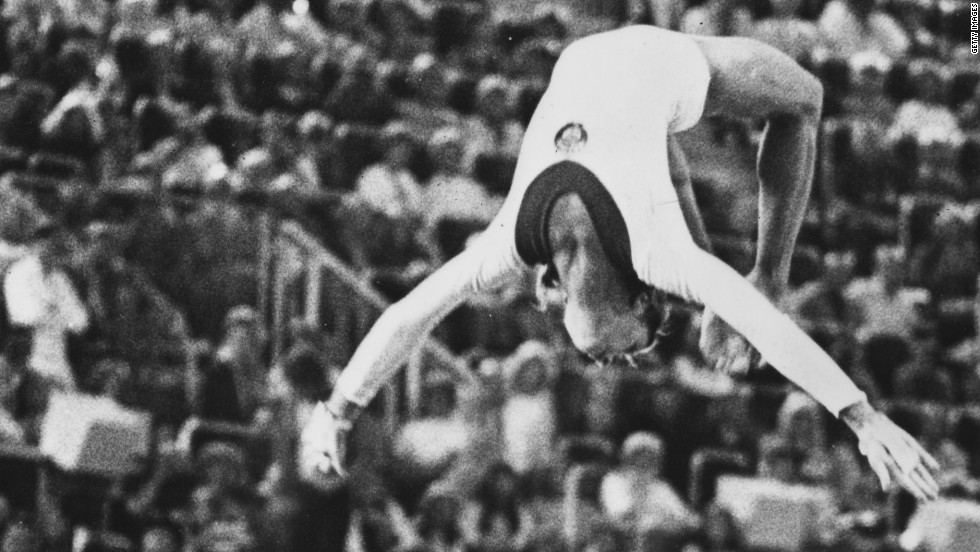Story highlights
- Former Soviet gymnast Olga Korbut helped redefine the sport
- She won three Olympics gold medals in 1972 and one in 1976
- She even has her own maneuver named after her -- the "Korbut flip"
- Korbut is one of 20 Olympic greats honored at a new exhibition
There are few Olympians who can say they redefined their sport, but that is what former Soviet gymnast Olga Korbut did at the 1972 and 1976 Olympics.
She won balance beam, floor exercises and team competition gold as well as silver in the uneven bars at the Munich Games, and then team competition gold and balance beam silver four years later in Montreal.
But she will be forever remembered for her "Korbut flip" -- a move so original and so groundbreaking that gymnastics would never be the same again.
The maneuver involved standing upright on the upper uneven bar mid-routine and executing a backflip, catching the upper bar from underneath it -- a move that has since been made illegal in accordance with the Olympic gymnastics Code of Points.
When she first performed the flip, at the age of 17 during a stunning routine at Munich, she was only awarded a score of 9.8, causing the onlooking crowd to go wild, jeering and booing at the judges for several minutes.
"I always wanted to try something different, we tried a lot of things," Korbut told CNN at London's Royal Opera House. "When you're doing something things just happen -- like going back from the high bar to the low bar. That's how it worked."
"After me, no one else did it. It had a risky element -- I had brought to gymnastics new gymnastics, new elements, not acrobatics. It is a mistake when it is said I brought acrobatics to the event."
Game-changing
Many of the moves which are now integral to modern gymnastics can be credited to Korbut's influence.
Pre-Munich, much emphasis had been placed on poise and elegance, while older and more experienced gymnasts made up the majority of the competition.
Now the sport is more dynamic with its participants primarily comprising youngsters that are on the cusp of adulthood, like Gabrielle Douglas of the United States -- the 4 foot 11 inch 16-year-old, who has won two gold medals in London at her first Games.
"If you see my routine from 1972 there's a lot of choreography, a lot of grace, and just a couple of new elements," said the 57-year-old Korbut, who acquired the nickname "The Sparrow from Minsk" after her first Olympic appearance.
"I was inspired by no one. I'm serious. It was the 1960s, we didn't have TV -- I was just born into gymnastics."
Following a post-gymnastics career as a teacher and divorce after a 23-year marriage to a Belorussian folk singer, Korbut now lives in the U.S., which explains her calm, confident English.
Her Munich routine might have been performed 40 years ago but the preparation she underwent to come so close to perfection is still ingrained in her memory.
"I didn't have a specific preparation. I just did it over and over again," Korbut recalled.
"You would just concentrate on what you've been doing for decades, and then show in just a moment what you've prepared for years and years.
"And of course, you still enjoy it. When you touch the equipment ... that's it -- you're in."
An inspiration
If much credit is given to Korbut's complex moves on the beam and bars for revolutionizing the sport, she also helped inspire a whole new generation of gymnasts.
"When I became famous for my gymnastics, it brought a lot of people to the gym, a lot of people having to pay money," she said.
"They were very talented, but money stopped the talented people attending gym. Unfortunately that was where it ended. Usually poor people have more of a hunger to work, I've seen it in life."
Forbes has estimated that the annual cost of an under-18 training program to be an Olympic-level gymnast is $15,000, which requires gymnasts to either have parents with very deep pockets or be willing to make huge financial sacrifices.
But, if gymnasts can transcend those financial cost, there are other great rewards to be had.
"You know what?" says Korbut, "to be in the Olympics is good, but to truly compete is great. It takes courage and hard work to compete. Everybody is a winner, I couldn't pick a best. Everyone who competes is great."
"The Olympic Journey: The Story of the Games" is an exclusive exhibition running from July 28 to August 12 at the Royal Opera House in London.




























